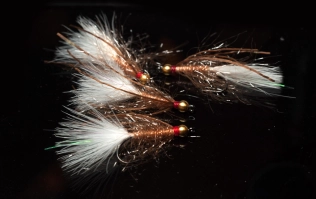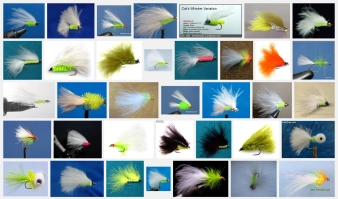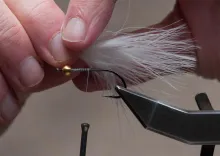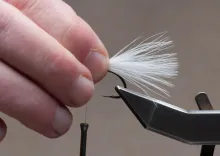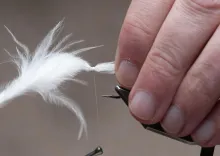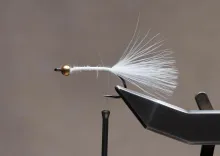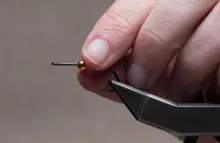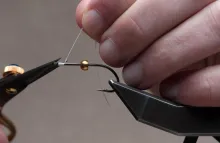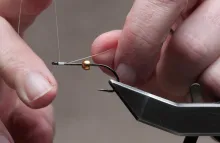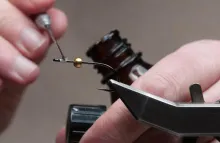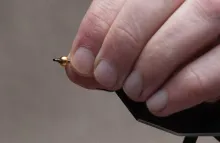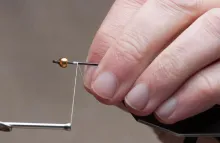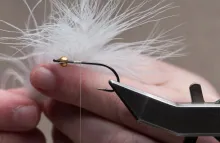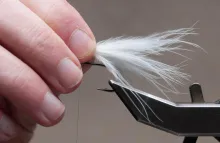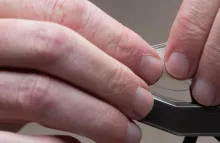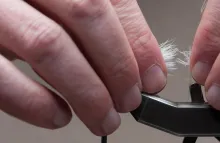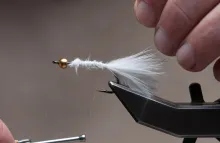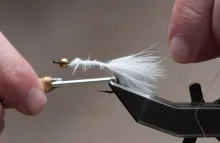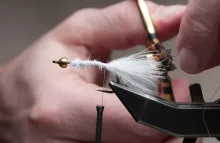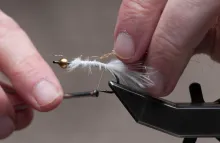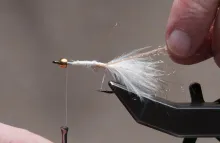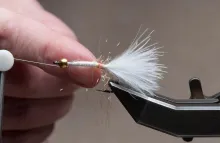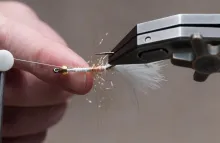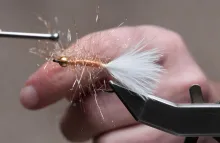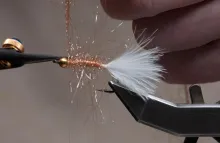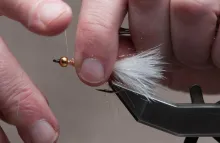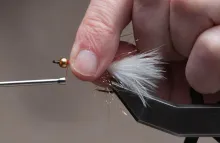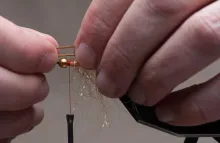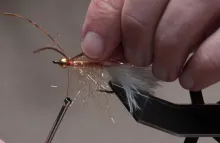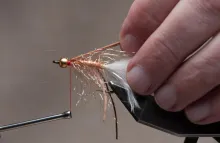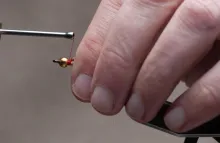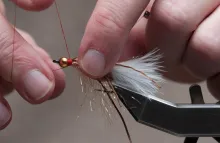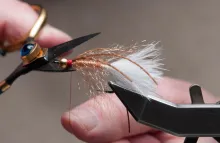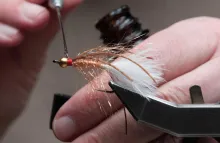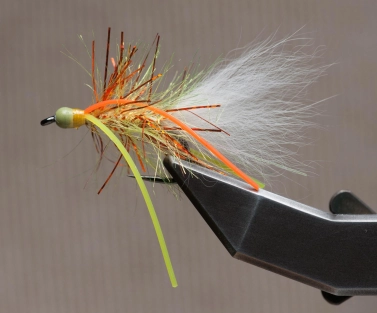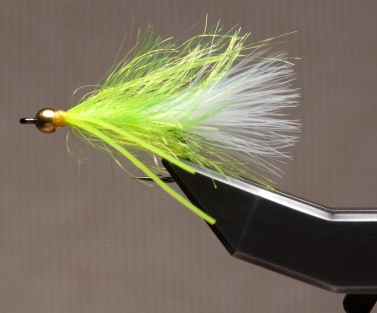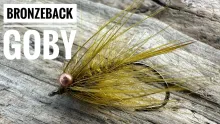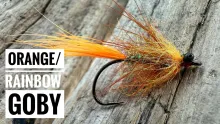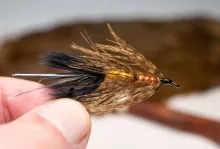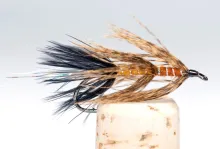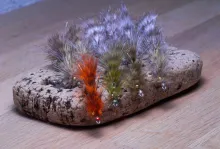This is a new take on another new take on the classic British stillwater pattern the Cat's Whisker
The original Cat's Whisker might be a very efficient streamer pattern for reservoir trout, but it's actually not a fly that I like very much – not that I fished it on a regular basis.
I find it slightly clumsy with its fat chartreuse chenille body and sort of helplessly large white marabou tail and wing. Chenille has never been my cuppa, and I'm not particularly enthused by Polar Shrimps, Montana Nymphs or other flies with chenille bodies. Add to that the large, almost triangular marabou wing as found on the Cat's Whisker, and I'm out.
To me
these flies look like something that has come from a very new fly-tyer's vise or from a child or someone not quite mature and not quite able to tie flies. Much like my own first flies, actually, which might be why I don't like them. It might sound harsh, but I say this will all kinds of respect for their originators - like David Train who originated the Cat's Whisker. It's a truly efficient attractor pattern, and a stable streamer - or lure as they say in the UK - in many British reservoir anglers' fly boxes. I just don't particularly like it.
But some time ago
I added a video to our video channel, showing a variation of the Cat's Whisker which I liked much better. The fly is tied by commercial tier Mak-Flies, whose flies as well as videos are very good. The variant has a different shape, but uses the same basic colors and almost the same materials. With the added flash and rubber legs as well as a bead, I'm sure this fly is at least as effective as the original - if not more.
But even though I'm sure the bright and colorful fly would work nicely for my local sea trout – not least in the cold season – my personal temper leans towards flies with more natural colors, and I decided to make a variation of Mak-Flies' variation of the Cat's Whisker.
Mak-Flies calls the first generation variant The Hot Flexi Cat's Whisker or even UV Fritz Flexi Killer Cat Trout Lure - nothing less. I decided to baptize mine the Lynx' Whisker. After all lynxes are so much more cool than cats, right? Contrary to domesticated cats with their delicate pelts, odd breeds and protected indoors lives, lynxes are wild animals, living in the woods, taking care of themselves. And lynxes have a grayish-brown fur marked with white, just perfect for a sea trout fly. The tufts on the ears make them even cooler if you ask me, but are pretty difficult to redo in a fly.
But a Cat's Whisker with the white marabou kept in, tan in stead of chartreuse for the body, no wing but rubber legs and a bead. That fly I would fish.
Martin Joergensen
For a hook
you can use your favorite ring or down eye, straight shank sea trout streamer hook. The hook needs to be larger than the usual British “lure” size, which is more like an 8 or 10, and I had some of the new Danish Ahrex NS110 hooks in a size 4 laying around, and they were perfect.
Mak-Flies uses a “synthetic hackle” called Crystal Hackle from UK supplier Flybox. I used several other substitutes for my flies, mainly Polar Chenille and Pseudo Hackle from Hareline, but also a product called Hybrid Synthetic Hackle from Cascade Crest. These synthetic hackles are all various flash products spun in a braided thread in such a way that they form barbs perpendicular to the thread. Hareline's Pseudo Hackle must be split down the middle before use, but is essentially the same type of product once it's prepared.
I have chosen
a 4 millimeter brass bead for most of my Lynx' Whiskers, but any bead that suits you and your hook of choice will do. I did a few with green Bidoz beads and some with Würm faceted tungsten beads. All work well, but some beads might require you to smash down the barb for them to pass the hook bend. The Würm beads I used have a slot in the back, and can pass over even very narrow hook bends. I usually lay down a thread foundation for the bead and secure it with varnish or superglue before tying the rest of the fly.
You can vary
The color of the body, the rubber legs and the bead endlessly, but I think it's suitable to keep the white tail since it is after all the only remaining legacy of the original Cat's Whisker. If you change that, you end up with something more like a Rubber Legged Woolly Bugger - which my Lynx' Whisker in essence already is, but I don't mind mind that...
Tying the Lynx' Whisker
isn't big art. It's a simple and rather crude fly with few materials, and only the tail can offer a small challenge. The tail is a squarely cut off marabout tail, and this can be made in a couple of ways. On Mak-Flies' video it's done with loose barbs cut off the side of a large marabou feather. These are tied in a little longer than needed, and then torn to the right length. This method works fine on the thin and evenly thick marabou barbs, and will leave a bushy and full tail. The method allows you to tie two or more flies from a single marabou feather.
Alternatively you can use a so called marabou blood quill, which has a pretty straight tip when the barbs are collected in a bunch. Simply pull all barbs parallel in a bunch and tie them in in the right length from the start. There's no trimming or tearing after this has been done, so get it right the first time. This leads to a tail, which is a little lighter and requires a whole feather for each fly.
The tail on the original is pretty long, and you see Cat's Whiskers with tails twice the hook length. I prefer something a little more controllable, and have kept the tail on the Lynx' Whisker about a shank length.
One feather tail
I also tied some flies with a rabbit fur tail. Fine, white rabbit fur has a lot of movement, and is easy to find. It has to be very fine and at least an inch long – preferably longer. Clip off a suitable bunch and hand stack it to even up the tips. Tie it in like your would the marabou, aiming for a large, bushy tail, about a shank length or slightly longer.
Tying steps
|
|
|
|
|
|
|
|
|
|
|
|
|
|
|
|
|
|
|
|
|
|
|
|
|
|
|
|
|
|
|
|
|
|
|
|
|
|
|
|
After having seen
my good friend Kai's Green Terror fly clear the shelves on many trips, and with the success of the original Cat's Whisker in mind, I have to say that I was tempted to tie up a few in a bright chartreuse along the UV Fritz Flexi Killer Cat Trout Lure lines shown by Mak-Flies in the video. They would be fun to try for this spring's fishing. These green flies have been very successful on many occasions, and even though we have no idea why, we do theorize about them being quite “UV bright”, and maybe extra attractive to the fish because of that fact. I can't totally deny that even a pink version might appear in my fly boxes. Pink is another of those very unnatural colors that seem to stir something in our Baltic sea trout, and the Polar Chenille used for this pattern comes in a very bright, pink and UV reflective version.
I had some pretty interesting Hybrid Synthetic Hackle from US supplier Cascade Crest, which is a synthetic hackle with two colors mixed. One of the combinations was chartreuse/copper, which combined with green and orange rubber legs gave a very nice version of this fly.
Martin Joergensen
- Log in to post comments

